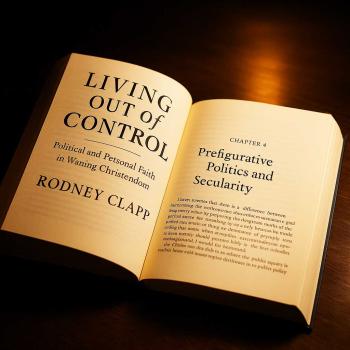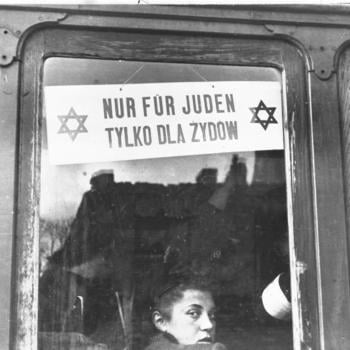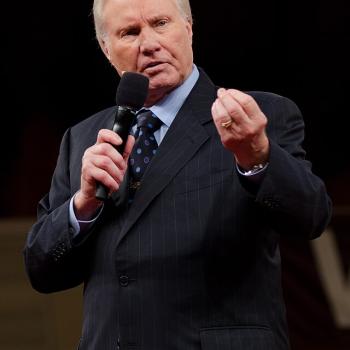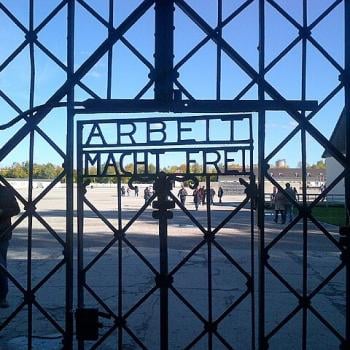Christian Thoughts about Our (American) New National Holiday: Halloween
Of course, it’s not really a “national holiday” in any formal or legal sense; schools, banks and government offices don’t close on October 31. By “new national holiday” mean that, in recent years, what used to be an evening for kids to go door-to-door “trick or treating” has evolved into a popular festival day with television, schools and clubs devoting much time and attention to…whatever it is that Halloween celebrates.
Many Christians, especially conservative evangelicals, have reacted vigorously and critically to the rise of Halloween. They point out that it often involves what philosopher Paul Ricouer labeled “the symbolism of evil” (although he meant something much more than the mostly silly occultism that accompanies a lot of Halloween celebrations). That is, as neo-paganism, Wicca and serious occultism have become more popular, or at least better known publicly, many Christians have shied away from any observance of Halloween because it often includes symbolism drawn from those sources.
Indeed, there are pagan and occult roots of Halloween. “Samhain” (pronounced “saw-win” or “sow-han”) is a pagan festival that allegedly goes back to pre-Christian European, especially Celtic, cultures. There are other terms for the same festival in other European languages. At least according to Wiccans and other neo-pagans, this is the night of the year (October 31-November 1) when the “veil” between the realms of the living and the dead is thinnest and the possibility of the spirits of the dead crossing over is greatest.
This may be why ancient European Christians “baptized” October 31 as “All Saints Eve”—the night before All Saints Day (November 1)—to counter pagan celebration perceived by Christians as opening the door to a demonic realm of activity.
Martin Luther, of course, nailed his “Ninety-five Theses” to the church door in Wittenberg on October 31, so many Protestants celebrate October 31 (or the Sunday nearest to it) as “Reformation Day.”
Some evangelical churches in America have “adopted” October 31 as a special opportunity for a kind of evangelism: “Hell Houses.” During the 1990s and first decade of this century, especially, numerous churches around the country have held religious-themed haunted house events promoting fear of hell.
When I was a kid growing up among conservative evangelical Christians in the Upper Midwest Halloween was simply an evening for children to get candy by dressing up in costumes and going door to door doing some kind of little “trick” (nothing mean or harmful—except for a few rogue teens later at night) and asking for a “treat”—usually a piece of candy. My parents, Pentecostals pastors both, didn’t discourage that, but frowned on using any occult symbolism in costumes or decorations. Ironically, though, some of my most vivid memories of childhood are of our church’s rather elaborate “haunted house” events around Halloween.
During the 1980s and 1990s a new awareness of the reality of serious occultism arose in America. Many newspapers, for example, featured “real witches” (Wiccans) in front page articles and described their covens and “Samhain” rituals. My first exposure to this was in 1980. I may have been dimly aware of it before then, but it seemed like such an obscure subculture that it wasn’t worth taking seriously. In 1980 I was co-teaching a university course (at the university where I was working on my Ph.D. in Religious Studies) entitled “Deity, Mysticism, and the Occult.” We used Ricoeur’s book The Symbolism of Evil to give the course serious scholarly content but also required students to read sociologist of religion Robert Ellwood’s Alternative Altars—a survey of non-traditional religions in North America including neo-pagan and occult religions (taken very seriously). The course was wildly popular among the undergraduates of the university partly because we invited guest speakers from various little-known and non-traditional religious movements to visit the class to speak.
The chairman of the Religious Studies Department of the university, who was also my supervisor and “official” teacher of the course (although he rarely attended it), offered me a relatively large sum of money to invite a scholar of “deity, mysticism and/or the occult” to fly in from virtually anywhere to speak to the class. I already knew whom I wanted to invite. A well-known researcher into neo- paganismand Wicca lived in suburban Chicago and I called him up and he agreed to come. I knew him to be a Christian, an ordained Methodist minister, as well as perhaps the most informed non-neo-pagan, non-Wiccan about those phenomena in America.
I met him at the airport when he arrived to speak to the evening class. He knew his assignment—to talk to the class about his research—and the first thing he said to me was “Let’s go find some real witches.” Needless to say, this then still “Pentecostal boy,” was shocked and bit afraid. I asked him how we would do that and he said “Where’s the nearest city phone directory yellow pages?” We found one and he looked under “Occult” in the yellow pages and found two entries. One was near the airport: “The Occult Shoppe.” So we drove there. It was a non-descript store front in a mostly industrial neighborhood. The only indication of its nature was a small sign that said “Occult Shoppe” over the entrance. It had a large plate glass window that was covered inside with curtains.
The scholar and I simply walked in; I stayed near the door. I was almost shaking with trepidation. He walked up to the glass counter containing all kinds of occult-related objects and began a conversation with the two women who owned the store. I listened and looked around. The one room open to the public (there were back rooms for “readings”) had a large pentagram inside a circle on the floor. The scholar informed me later that indicated it was a site for neo-pagan rituals; a coven met there. After he mentioned the names of some nationally-known neo-pagan/Wiccan leaders he knew personally, the women relaxed and answered his questions. They claimed the store “served” about fifty Wiccan covens of several kinds (not Satanists) in the northern part of that large city. They said there were many more covens than that in that city of about two million people. As I examined the not-very-light room I saw pictures of the Mother Goddess and her consort the “horned god,” many jars of herbs and potions and numerous books about the occult.
The scholar informed me that such stores existed in most major cities in America and that some are open to the public and some are not. Since then I have seen many similar stores in cities around the country. Throughout the 1980s and 1990s Wicca, especially, became more “exoteric” and less “esoteric.” Eventually, at one college where I taught an annual course on America’s Cults and New Religions I became acquainted with two Wiccans—a priestess of a “Dianic” coven (women only) and a member of a mostly gay coven. Both spoke to my class about neo-paganism and Wicca. Both insisted their religion has nothing to do with Satanism. I became convinced that, while they were serious and meant what they said, the “line” between some Wicca and some Satanism is rather thin—at least from a Christian point of view.
(Sidebar: My Wiccan priestess speaker told my class that her Dianic coven met in the basement of a large downtown church—with the church’s “blessing.” She also said that they did not sacrifice animals but vegetables. What vegetables? Pomegranates. I’ll leave it to you, dear readers, to figure out why.)
As a result of the “going public” of Wicca and other neo-pagan religions, and as a result of greater awareness (including some outright paranoia) about Satanism, many conservative evangelical churches dropped Halloween entirely and substituted other, more Christian-themed, events (always with candy, of course) to discourage their kids from even going trick-or-treating. Of course, the public paranoia about “poisoned candy” and candy bars with razor blades in them contributed to that phenomenon. Some hospitals went so far as to offer free X-ray examinations of trick-or-treat candy—to expose any razor blades or other harmful objects that may have been inserted in them.
Through all of that, my wife and I took our daughters trick-or-treating—sometimes in the snow! (One Halloween evening that city received thirty-four inches of snow! We took them trick-or-treating anyway—at their insistence, of course—but only until the snow was knee deep.) We dampened down on the occult symbolism but didn’t abandon Halloween altogether.
However, if I’m not mistaken, it seems to me that public schools, television, and even businesses have recently gone overboard celebrating Halloween. When I was as kid there may have been some minor Halloween observance at school, and that was the case when my daughters were in public schools, but now many public schools devote the whole day (October 31 or the day before if it falls on a Saturday as this year) to the it. Nearly all prime time network television programs devote the episode before or on Halloween to it. It has become an unofficial national American holiday. Why? Because America has bought into occultism? I don’t think so.
The reason is because it is one “holiday” without overt religious content or connotation. In our political correctness and out of desire not to offend non-Christians, we, to a very large extent, have put the brakes on Christmas—especially in public schools but also in many businesses (except insofar as they can use it to make money, but without any religious symbolism). I think we, as a culture and society, have tended to hype Halloween because it is perceived as a non-religious holiday so no one should be offended.
I once was asked to attend a public school board’s special meeting to discuss the observance and celebration of Halloween in its schools. A group of fundamentalist parents had objected to a school’s requiring students to role play being witches and wizards in a certain “fun” learning event. The kids didn’t want to and then parents tried to make their case that this was no different, really, from requiring atheist students from pretending to be saints or apostles or priests—because Wicca and neo-paganism are real religions, not mere fantasy. I spoke for them on that particular point—revealing the reality, the seriousness, of neo-paganism and Wicca as religious forms of life. That particular school board treated the complaining parents and me as would-be fundamentalist censors and controllers of curricula. They were extremely hostile to us. All the parents were asking is that their kids, and others, be offered the opportunity to “opt out” of such events insofar as they offended their religious sensibilities. The school board scoffed at the idea and basically rejected the whole plea. I was appalled.
(Sidebar: When I invited Wiccans to speak to my class I always offered students the opportunity to be absent without any penalty. A few usually opted for that and stayed away that day. I also forbid the speakers from doing anything other than explaining and answering questions. The priestess once attempted to get the class to participate with her in a ritual of “earth healing.” I stopped her. Occasionally a parent or two would call to complain about that aspect of the course. I routinely asked them if they wanted their student to encounter Wiccans and other neo-pagans in a Christian environment where we examined their beliefs and practices critically and prayed for them and where I explained why they are mistaken in their beliefs from an evangelical Christian point of view, or to encounter them first outside such an environment. That usually, perhaps always, stopped them from objecting to the president. I no longer teach any similar course; my teaching for the past sixteen plus years had focused solely on Christian theology. Then, in the 1980s and 1990s, it included religion and culture classes such as “America’s Cults and New Religions” which I advertised to students as it was an elective, as “Unsafe Sects.” One young male student had only heard, not seen, that unofficial title of the course and walked out when he discovered it was a religion course! Figure it out.)
So, to wrap it all up. I have no objection to “trick or treating.” In fact, I am looking forward to going trick or treating with my grandchildren this Saturday. Nor do I object to “haunted house” events so long as they do not go overboard and traumatize children. I do worry, however, that our culture may be going overboard with Halloween observance and celebration to the detriment of other, perhaps more culturally serious, holidays. I am ambivalent about Halloween. The rule I would suggest to Christian parents and pastors is: no occult symbolism. I do think occultism can become obsessive for some young people and it can be (from my evangelical Christian perspective) a door into a demonic realm. That’s a door best not opened.
Note to potential commenters: I do not permit people to “take over” my blog to promote their own religions, philosophies or worldviews. This is admittedly and openly and evangelical Christian blog; that is the perspective from which it is written and the section of Patheos where it appears. Feel free to correct anything that is factually in error, but I will not approve and post comments that attempt to “preach” or promote alternative religions, philosophies or worldviews. I always welcome sincerely asked questions.












